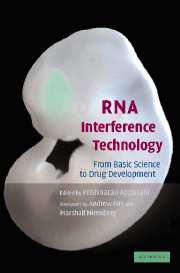Book contents
- Frontmatter
- Contents
- Foreword by Andrew Fire
- Foreword by Marshall Nirenberg
- List of Contributors
- Introduction
- Section one Basic RNAi, siRNA, microRNAs and gene-silencing mechanisms
- Section two Design, synthesis of siRNAs
- Section three Vector development and in vivo, in vitro and in ovo delivery methods
- Section four Gene silencing in model organisms
- Section five Drug target validation
- Section six Therapeutic and drug development
- Section seven High-throughput genome-wide RNAi analysis
- 30 High-throughput RNAi by soaking in Caenorhabtis elegans
- 31 Tools for integrative genomics: Genome-wide RNAi and expression profiling in Drosophila
- 32 Microarray analysis and RNA silencing to determine genes functionally important in mesothelioma
- 33 High-throughput RNA interference
- 34 Generation of highly specific vector-based shRNAi libraries directed against the entire human genome
- Index
- Plate section
- References
30 - High-throughput RNAi by soaking in Caenorhabtis elegans
Published online by Cambridge University Press: 31 July 2009
- Frontmatter
- Contents
- Foreword by Andrew Fire
- Foreword by Marshall Nirenberg
- List of Contributors
- Introduction
- Section one Basic RNAi, siRNA, microRNAs and gene-silencing mechanisms
- Section two Design, synthesis of siRNAs
- Section three Vector development and in vivo, in vitro and in ovo delivery methods
- Section four Gene silencing in model organisms
- Section five Drug target validation
- Section six Therapeutic and drug development
- Section seven High-throughput genome-wide RNAi analysis
- 30 High-throughput RNAi by soaking in Caenorhabtis elegans
- 31 Tools for integrative genomics: Genome-wide RNAi and expression profiling in Drosophila
- 32 Microarray analysis and RNA silencing to determine genes functionally important in mesothelioma
- 33 High-throughput RNA interference
- 34 Generation of highly specific vector-based shRNAi libraries directed against the entire human genome
- Index
- Plate section
- References
Summary
Introduction
The phenomenon of RNA-mediated interference (RNAi) was first discovered in the nematode Caenorhabditis elegans (Fire et al., 1998), in which introduction of double-stranded RNA (dsRNA) causes specific inactivation of genes with corresponding sequences. RNAi was soon recognized as an experimentally simple and technically undemanding method for gene knockdown in this organism. The emergence of this new technology, which coincided with the completion of the sequencing of the C. elegans genome (The C. elegans Sequencing Consortium, 1998), has brought about a dramatic shift in the experimental strategies adopted in the study of this organism, and greatly expanded our understanding of gene function at the whole-genome level. Our group have established an optimized “soaking method” for dsRNA delivery into worms (Maeda et al., 2001), and applied this technique for large-scale analysis of gene function. In this paper, I describe the characteristics of the “soaking method,” and its application in the study of developmental processes in C. elegans.
RNAi in C. elegans
After the finding of RNAi in C. elegans, a series of subsequent analyses demonstrated that wide range of animals, plants, and fungi has RNAi-related gene regulatory mechanisms (Cogoni and Macino, 2000). Biochemical and genetic approaches, conducted mainly in C. elegans and Drosophila, have revealed the evolutionarily conserved nature of the molecular mechanism of RNAi (see other chapters in this book for detail). Although the “core RNAi mechanism” appears to be conserved among diverse organisms, some aspects of RNAi observed in C. elegans are not universally found in other species.
Information
- Type
- Chapter
- Information
- RNA Interference TechnologyFrom Basic Science to Drug Development, pp. 419 - 432Publisher: Cambridge University PressPrint publication year: 2005
References
Accessibility standard: Unknown
Why this information is here
This section outlines the accessibility features of this content - including support for screen readers, full keyboard navigation and high-contrast display options. This may not be relevant for you.Accessibility Information
- 4
- Cited by
